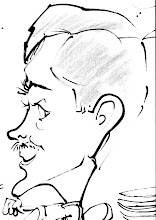TRY TO COMMENT ON THIS NOTION: What if we were to suppose that all the kinds of thinking that we do are actually one thinking in different degrees. Perhaps all the thinking(s) that we do are like the subtle color spectrum in white light, that a prism can separate. We can name the colors, even number them. Can we arrange all thinking into a spectrum assuming that it comes out of white light (or a white noise) of thought?
Might I suggest that readers: 1.) select words from the previous blog comments or choose your own thought-words that seem to name thinking types and 2.) arrange them in a spectrum in which one overlaps, boarders, feeds into or intertwingles* another.
In the end, it may be that all our thoughts may not only be in a linear design but be more circular or web-like. But let us start out with the linear spectrum until we have defined thinking this way.
*intertwingles is my word that combines intertwined and intermingled which may be appropriate for the spectrum of thought.
Copyright 2007 by Christopher Parker
Saturday, January 13, 2007
Subscribe to:
Post Comments (Atom)

4 comments:
Your analogy is interesting. It's like the Native American Eskimo who has 100's of words to describe the different types of snow.
The difficult part of this request is that our thinking is limited to our own biological framework. What you seek to define in such detail and cross referenced spectrum analysis is an intefismally small portion of the earth's thoughts.
Is there thought outside our human boundaries? Plant thought, global thought, terrestrial thought?
Assuming you don't want thinking on that plane then we left with our own biological thought which probably runs through some milestones. Like Stanley Milgrams or was it Maslow's Hierarchy of Needs. Survival, clothing, warmth, food, water, nurturing, love, wealth, greed, compassion, luxury, victory. Tolstoy tried to examine all religions of the world to determine if there was a true divine influence or if divinity was a biological necessity. Then, assuming that thought is based upon biological needs, what is to be said of cultural influences? Do those societal structures change the key elements of biological thought or just the prioritization or spectrum?
Okay... you've got me thinking here (definitely in a web-like manner).
What if a person knows what/how they should be thinking logically; but their mind contradicts what they know to be logical?
Do we have reflexes in our thought processes? For example - if we take a thought to its limit - is that limit set by a reflex that doesn't allow us to go further? If limited by a reflex can we retrain ourselves and stretch further?
I really like your word "intertwingle".
BTW, I have 2 canines who have fairly deep thoughts.
Canine and feline thought go as deep as the food dish. They are basic survival thoughts and would best be defined as biological. Your human impression upon these non-emotive creatures is merely anthropomorphism.
How can a dog really feel stress as my veterinarian tells me about my dog Wrecks?
Darrel
Hope, I think your question describes the reason people bungee jump.
Post a Comment